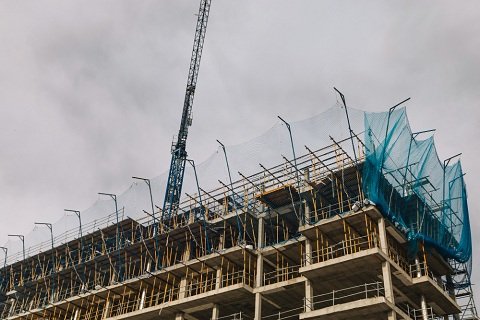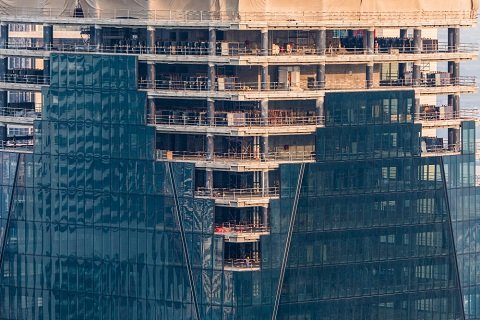Scaffolding plays a crucial role in various industries, providing essential support structures for workers to access elevated areas safely and perform tasks efficiently. While scaffolds are most commonly associated with the construction industry, their utility extends far beyond building sites, encompassing diverse sectors such as oil and gas, shipbuilding, mining, and even the film and entertainment industry. In this comprehensive article, we will explore the multifaceted role of scaffolding in different industries, examining its applications, challenges, and contributions to safety and productivity.
1. Construction Industry
The construction industry is perhaps the most prominent user of scaffolding, relying heavily on these temporary structures to facilitate building, renovation, and maintenance projects. Scaffolds provide workers with safe access to elevated areas, such as building exteriors, roofs, and facades, allowing them to perform tasks such as painting, plastering, welding, and installation of building components.
In construction, scaffolds come in various types and configurations, including frame scaffolds, tube and coupler scaffolds, modular systems, and mast climbing work platforms. Each type offers unique advantages in terms of versatility, load capacity, and ease of assembly, catering to the specific requirements of different construction projects.
Moreover, scaffolding in the construction industry must adhere to stringent safety regulations and standards, such as those set forth by the Occupational Safety and Health Administration (OSHA) in the United States. Compliance with safety protocols is essential to prevent accidents, injuries, and fatalities on construction sites, underscoring the importance of proper scaffold design, erection, inspection, and maintenance.
2. Oil and Gas Industry
In the oil and gas industry, scaffolding plays a critical role in supporting maintenance, inspection, and repair activities on offshore platforms, drilling rigs, refineries, and petrochemical plants. These industrial facilities often feature complex structures and equipment located at heights or in confined spaces, necessitating the use of scaffolds to provide safe access for workers and equipment.
Scaffolding in the oil and gas industry must withstand harsh environmental conditions, including exposure to saltwater, high winds, and corrosive chemicals. Therefore, scaffold materials must be selected carefully to ensure durability, corrosion resistance, and structural integrity in offshore and onshore environments.
Additionally, safety is paramount in the oil and gas industry, where workers face numerous hazards, including falls, confined spaces, and exposure to hazardous substances. Rigorous safety training, adherence to industry standards, and implementation of best practices are essential to mitigate risks and ensure the well-being of workers performing scaffold-related tasks.
3. Shipbuilding and Maritime Industry
Shipbuilding and maritime operations require specialized scaffolding solutions to support construction, repair, and maintenance activities on ships, vessels, docks, and offshore structures. Scaffolds in the maritime industry must be designed to withstand dynamic forces such as waves, currents, and vessel movements, as well as exposure to saltwater and marine environments.
Shipbuilding scaffolds are often tailored to the unique requirements of naval architecture, accommodating curved surfaces, irregular shapes, and varying elevations found in ship hulls and superstructures. Advanced scaffold designs, such as hanging scaffolds, suspended platforms, and rigging systems, are employed to access hard-to-reach areas and facilitate welding, painting, blasting, and outfitting tasks.
Furthermore, safety is of paramount importance in the maritime industry, where workers face additional risks associated with working at sea, such as slippery surfaces, unstable platforms, and inclement weather conditions. Comprehensive safety training, adherence to maritime regulations, and implementation of preventive measures are essential to ensure the safety and well-being of workers engaged in scaffold-related activities.
4. Mining Industry
In the mining industry, scaffolding plays a vital role in supporting excavation, construction, maintenance, and exploration activities in underground mines, open-pit mines, and quarrying operations. Scaffolds are used to access high walls, ore bins, processing plants, and equipment installations, enabling workers to perform tasks such as drilling, blasting, scaling, and equipment maintenance.
Mining scaffolds must be designed to withstand rugged terrain, uneven surfaces, and harsh environmental conditions prevalent in mining environments. Additionally, scaffolds in mining operations must comply with safety regulations and standards established by mining authorities to prevent accidents, collapses, and falls from heights.
Moreover, safety is a top priority in the mining industry, where workers face numerous hazards, including rockfalls, equipment accidents, and exposure to dust, noise, and toxic gases. Rigorous safety training, implementation of safety protocols, and regular inspections are essential to mitigate risks and ensure the safety and well-being of miners working in scaffold-supported environments.
5. Film and Entertainment Industry
In the film and entertainment industry, scaffolding serves as a versatile and adaptable solution for creating temporary structures, sets, and platforms for film shoots, concerts, theatrical performances, and events. Film crews and production teams use scaffolds to build elevated camera platforms, lighting rigs, stage sets, and audience seating arrangements, enabling them to achieve desired visual effects and camera angles.
Scaffolding in the film and entertainment industry must be designed to accommodate the specific requirements of each production, including set design, location constraints, and safety considerations. Scaffold configurations range from basic platforms and towers to elaborate structures incorporating catwalks, stairs, and decorative elements to enhance visual appeal and functionality.
Safety is paramount in the film and entertainment industry, where workers and performers are exposed to elevated heights, moving equipment, and complex staging setups. Rigorous safety protocols, coordination with production teams, and adherence to industry standards are essential to prevent accidents, injuries, and disruptions during film shoots and live events.
6. Aerospace Industry
In the aerospace industry, scaffolding is essential for the construction, maintenance, and repair of aircraft, spacecraft, and related facilities. Aircraft hangars, assembly plants, and maintenance facilities require scaffolds to provide access for technicians, mechanics, and engineers working on aircraft fuselages, wings, engines, and other components.
Scaffolding in the aerospace industry must meet stringent safety and quality standards established by aviation authorities, ensuring structural integrity, stability, and reliability in highly regulated environments. Aerospace scaffolds may incorporate specialized features such as aircraft docking systems, adjustable platforms, and aircraft maintenance stands designed to accommodate different aircraft models and configurations.
Moreover, safety is paramount in the aerospace industry, where workers are exposed to hazards such as falls, electrocution, and foreign object debris (FOD). Comprehensive safety training, strict adherence to aviation regulations, and implementation of safety protocols are essential to protect workers and prevent accidents during scaffold-supported operations.
7. Renewable Energy Industry
In the renewable energy industry, scaffolding is instrumental in the construction, maintenance, and repair of wind turbines, solar panels, hydroelectric dams, and other renewable energy infrastructure. Scaffolds provide access for technicians, engineers, and maintenance crews to perform installation, inspection, and servicing tasks on renewable energy systems located at heights or in remote locations.
Renewable energy scaffolds must withstand challenging environmental conditions, including exposure to wind, rain, snow, and extreme temperatures. Scaffold designs may incorporate features such as weatherproof materials, anchoring systems, and safety railings to ensure stability and worker safety in outdoor environments.
Additionally, safety is a top priority in the renewable energy industry, where workers face risks such as falls from heights, electrical hazards, and machinery accidents. Rigorous safety training, compliance with industry standards, and implementation of safety procedures are essential to prevent accidents, injuries, and downtime in renewable energy operations.
Here are some FAQs about Exploring the Role of Scaffolding in Different Industries
Scaffolding plays a crucial role in the building industry by providing temporary support and access for workers to perform tasks such as masonry, painting, plastering, and facade installation. It ensures safety, efficiency, and accessibility on construction sites, allowing for work at height to be completed effectively.
In shipbuilding and maritime industries, scaffolding is used to provide access to ship hulls, decks, and interiors during construction, repair, and maintenance activities. It allows workers to perform tasks such as welding, painting, and equipment installation in challenging maritime environments.
Scaffolding is essential in the oil and gas industry for providing access to offshore platforms, refinery structures, and other facilities for inspection, maintenance, and construction work. It ensures the safety of workers operating in hazardous environments and allows for efficient completion of tasks at height.
In the entertainment and event industry, scaffolding is used to construct temporary stages, platforms, lighting rigs, and seating structures for concerts, festivals, and other events. It provides support for equipment, performers, and audience members, ensuring the success and safety of live events.
In the manufacturing sector, scaffolding is utilized for assembly, maintenance, and repair of large equipment, machinery, and industrial facilities. It provides access to elevated work areas, allowing workers to perform tasks such as installation, inspection, and cleaning efficiently and safely.
Scaffolding is used in the film and television production industry to create temporary structures for filming locations, sets, and special effects. It provides support for camera platforms, lighting fixtures, and rigging equipment, enabling filmmakers to achieve desired visual effects and scenes safely and efficiently.
In infrastructure projects, scaffolding is employed to provide access for construction, repair, and maintenance activities on bridges, tunnels, highways, and other transportation structures. It facilitates work at height and in confined spaces, ensuring the safety and integrity of critical infrastructure assets.
Conclusion
Scaffolding plays a diverse and indispensable role in various industries, providing essential support structures for accessing elevated areas and performing tasks safely and efficiently. From construction and oil and gas to shipbuilding, mining, and the film and entertainment industry, scaffolds enable workers to overcome challenges and achieve their objectives in diverse work environments.
As industries continue to evolve and face new challenges, the role of scaffolding will remain essential, driving innovation, safety, and productivity across different sectors. By embracing advanced technologies, adhering to safety regulations, and prioritizing worker training and well-being, companies can harness the full potential of scaffolding to enhance operations, achieve greater efficiencies, and ensure success in their respective industries.
This article highlights the diverse applications of scaffolding across various industries, emphasizing its critical role in facilitating work at heights and ensuring safety and efficiency in different work environments.
References:
- Occupational Safety and Health Administration (OSHA). (n.d.). Scaffolding. https://www.osha.gov/scaffolding
- International Maritime Organization (IMO). (n.d.). Maritime Safety. https://www.imo.org/en/OurWork/Safety
- Marine Insight. (2021). Scaffolding in Ship Construction. https://www.marineinsight.com






